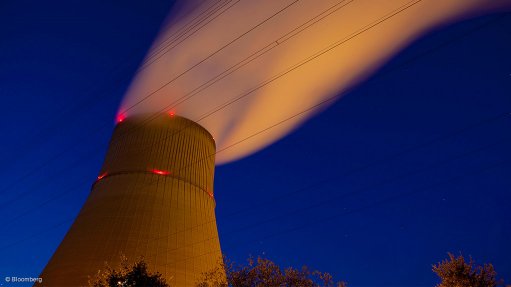
Photo by: Bloomberg
The procurement process for South Africa’s new build nuclear energy programme will start in the second quarter of this year and be completed by the end of the 2015 financial year with the selection of either a single or a group of strategic partners, the Department of Energy (DoE) has revealed.
In an update on government’s nuclear procurement process, in Durban, on Tuesday, DoE deputy director-general for nuclear energy Zizamele Mbambo said the first new nuclear power station would come on line in 2023.
Although the site for the first power plant had yet to be finalised, the Eastern Cape, Northern Cape, Western Cape and KwaZulu-Natal had been identified as suitable locations. Further scoping was under way to identify other sites where both affordable power and industrialisation were most needed.
Government intended to build between six and eight nuclear power plants.
The bid invitation specification and related evaluation criteria would be finalised by the end of July and government was expected to complete its financing arrangements for the new build programme shortly.
“Today, our economy is hungry for base-load electricity that is affordable,” South African Nuclear Energy Corporation CEO Phumzile Tshelane said.
He added that South Africa was building an income-generating asset that would not only pay for itself but generate profits that would pay for other nuclear power stations to be built.
However, the real value would be that the economy would no longer be hobbled by load-shedding and thus able to function better.
Although figures of R1-trillion have been bandied about, Mbambo would not disclose government’s budget for the nuclear energy procurement programme, saying this would only become known once various vendors had put forward prices for specific projects.
“Government has completed various technical studies in response to the National Development Plan directives. These include in-depth studies into the cost of nuclear power, funding and financing models and economic impact on localisation. It is important to note that government is still to negotiate the price tag in the procurement process, which is why exact figures cannot be made available at this stage,” he said.
However, he did refer to current global costs. These indicate an overnight cost of around $5-billion per 1 200 MW reactor, which was equivalent to $4 200/kW in “newcomer States” such as the United Arab Emirates, Pakistan, Turkey and Belarus. In countries with established domestic construction programmes such as China, South Korea and India, the prices were around $2 500/kW.
Mbambo added that a funding model could not be discussed for strategic reasons. However, the studies conducted had indicated to government that the nuclear programme was both financeable and would contribute positively to South Africa’s economy through localisation and job creation.
South Africa’s Nuclear Energy Policy, which was approved in 2008, provided a framework that covered prospecting, milling, mining, the use of nuclear materials and the development and use of nuclear energy for peaceful purposes.
In March 2011, Cabinet approved a 20-year Integrated Resource Plan that included a mixed energy agenda that specified that nuclear power stations would provide 9 600 MW of energy, or 23% of overall energy generation, by 2030.
Mbambo noted that these documents, which were currently “undergoing internal processing”, would be made public. He did not specify a date.
However, he said various other framework and research documents on which government had based its decisions would not be made public, as this would compromise the procurement process and the roll-out of the country’s nuclear strategy.
Moving on to specifics, Mbambo said government had conducted an Integrated Nuclear Infrastructure Review (INIR) in accordance with International Atomic Energy Agency (IAEA) guidelines.
He added that a contracting strategy and an integrated nuclear fuel cycle strategy that included spent fuel or high-level waste disposal had been completed.
Further, the designation of a procuring agency – in this case the DoE – to initiate the necessary organisational provision, including human resource development, had also been finalised.
In terms of the IAEA guidelines, South Africa was required to amend its nuclear legislation and explicitly address fundamental safety principles, including assigning prime responsibility for safety to a specified operator. The amendment of the National Nuclear Regulator and Nuclear Energy Acts was under way.
Further, in terms of the INIR, South Africa had to join the relevant legal international instruments on civil liability for nuclear damage, complete regulations on nuclear security and safeguards and complete the process of revising its legislative framework to address the independence of the regulatory body, nuclear security and civil liability for nuclear safety. All were in the final stages of completion and processing with relevant authorities.
Mbambo said the INIR also specified that South Africa needed to develop and implement a national human resource strategy to address required improvements in technical subjects at secondary school level, graduation rates for university engineering programmes and training of artisans in areas relevant to the nuclear industry.
Various intergovernmental agreements (IGAs) would play a role here, and government had, to date, signed IGAs with China, France, Russia, the US and South Korea. Negotiations were under way to also conclude IGAs with Canada and Japan.
Mbambo stressed that these laid the foundation for cooperation, trade and exchange of nuclear technology, as well as procurement.
Referring to speculation that the signing of training agreements with China and Russia indicated that entities from these countries were preferred bidders, he said no deals were on the table and stressed that the procurement process was yet to begin.
However, he stressed that training was imperative, as South Africa intended to be “self-sufficient within the nuclear value chain in the long term”.
Another key factor when it came to self-sufficiency was localisation, both in terms of construction of plants and manufacturing of equipment for nuclear power plants.
For turnkey projects, localisation of between 30% and 35% was achievable; however, as South Africa’s power plants were not turnkey projects, government hoped to achieve about 80% localisation over ten years.